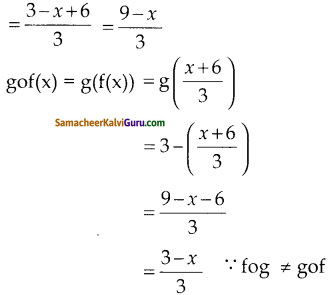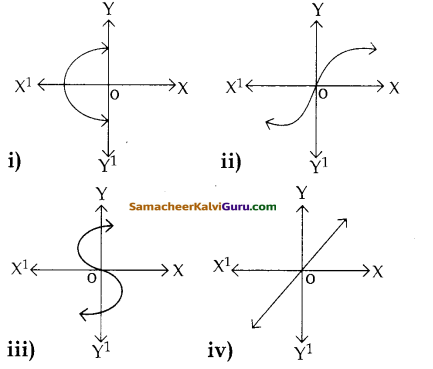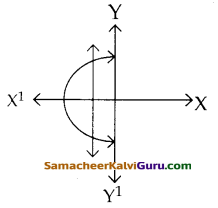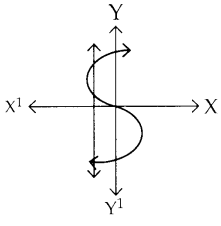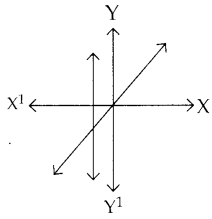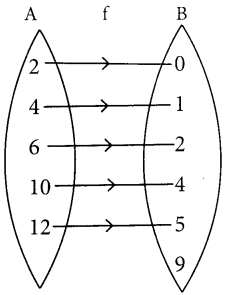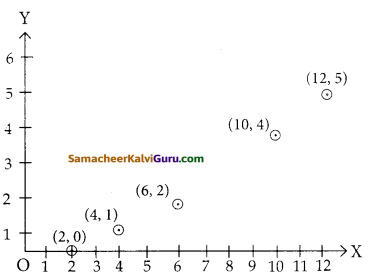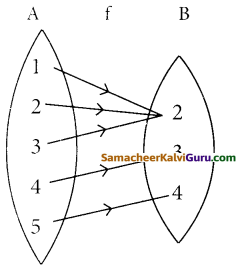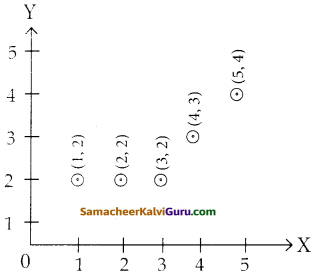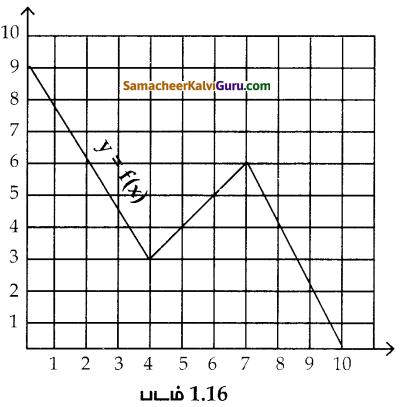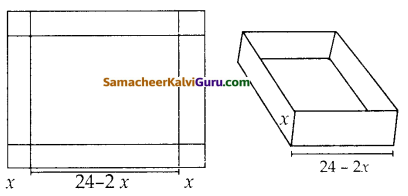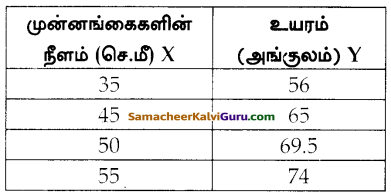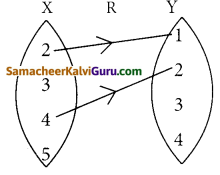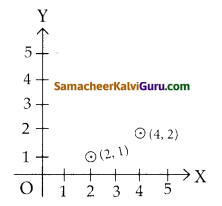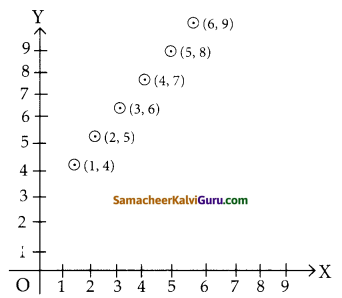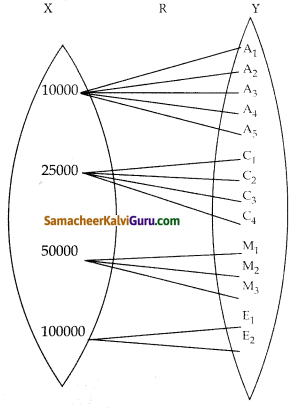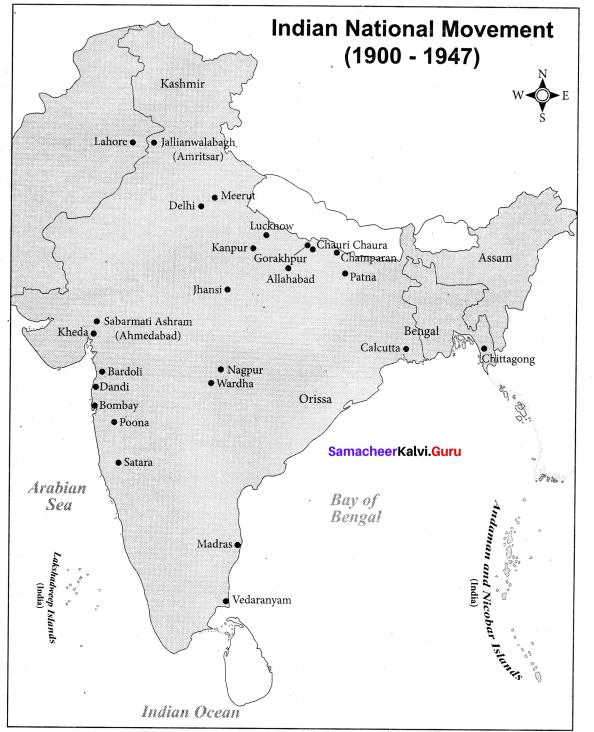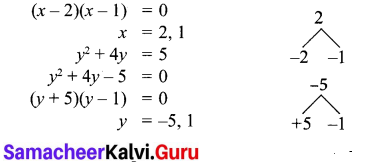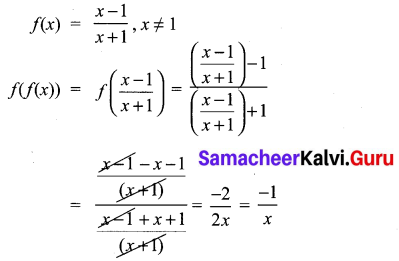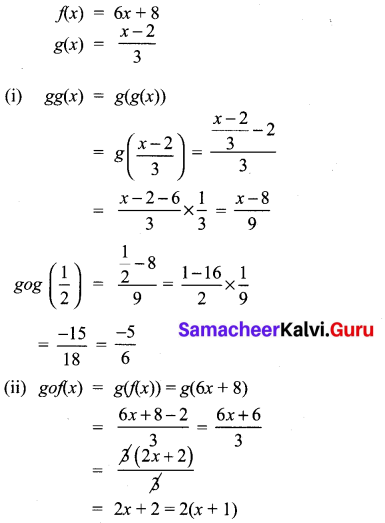Tamilnadu State Board New Syllabus Samacheer Kalvi 10th Maths Guide Pdf Chapter 1 உறவுகளும் சார்புகளும் Ex 1.6 Textbook Questions and Answers, Notes.
TN Board 10th Maths Solutions Chapter 1 உறவுகளும் சார்புகளும் Ex 1.6
பலவுள் தெரிவு வினாக்கள்
கேள்வி 1.
n(A × B) = 6 மற்றும் A = {1, 3} எனில் n(B) ஆனது
அ) 1
ஆ) 2
இ) 3
ஈ) 6
விடை :
இ) 3
n(A × B) = 6
n(A) = 2
n(B) = \(\frac{n(A \times B)}{n(A)}=\frac{6}{2}\) = 3
கேள்வி 2.
A= {a, b, p}, B = {2, 3} C = {p, q, r, s} எனில், n[(A ∪ C) × B] ஆனது
அ) 8
ஆ) 20
இ) 12
ஈ) 16
விடை :
இ) 12
![]()
A∪C = {a, b, p, q, r, s} = n(A∪C) = 6
B = {2,3} ⇒ n (B) = 2
n[(A ∪ C × B)] = 6 × 2 = 12
கேள்வி 3.
A = {1, 2}, B = {1, 2, 3, 4}, C = {5, 6} மற்றும் D = {5, 6, 7, 8} எனில் கீழே
கொடுக்கப்பட்டவைகளில் எது சரியான கூற்று?
அ) (A × C) ⊂ (B × D)
ஆ) (B × D) ⊂ (A X C)
இ) (A × B) ⊂ (A × D)
ஈ) (D × A) ⊂ (B × A)
விடை :
அ) (A × C) ⊂ (B × D)
A × C = {1, 2} x {5, 6}
= {(1, 5) (1, 6) (2, 5) (2, 6)}
B × D = {1, 2, 3, 4} × {5, 6, 7, 8}
= {(1, 5) (1, 6) (1, 7) (1, 8) (2, 5) (2, 6) (2, 7) (2,8) (3, 5) (3, 6) (3, 7) (3, 8) (4, 5) (4, 6) (4, 7) (4, 8)}
∴ (A × C) ⊂ (B × D)
கேள்வி 4.
A = {1, 2, 3, 4, 5} -லிருந்து, B என்ற கணத்திற்கு 1024 உறவுகள் உள்ளது எனில் B -ல் உள்ள உறுப்புகளின் எண்ணிக்கை.
அ) 3
ஆ) 2)
இ) 4
ஈ) 8
விடை :
ஆ) 2
![]()
n(A) = 5 = p
n(B) = ? = q
2pq = 1024
25q = 10
5q = 10
q = 2
கேள்வி 5.
R = {(x, x2 ) |X ஆனது 13 – ஐ விடக் குறைவான பகா எண்கள் } என்ற உறவின் வீச்சகமானது
அ) {2, 3, 5,7}
ஆ) {2, 3, 5, 7, 11}
இ) {4, 9, 25, 49, 121}
ஈ) {1, 4, 9, 25, 49, 121}
விடை :
இ) {4, 9, 25, 49, 121}
13 விட குறைவான பகா எண்கள் {2,3, 5, 7, 11}
தரவு f(x) = x2
f(2) = 22 = 4
f(3) = 32 =9
f(5) = 52 = 25
f(7) = 72 = 49
f(11) = 112 = 121
வீச்சகம் = {4, 9, 25, 49, 121}
கேள்வி 6.
(a + 2, 4) மற்றும் (5, 2a + b) ஆகிய வரிசைச் சோடிகள் சமம் எனில், (a, b) என்பது
அ) (2, -2)
ஆ) (5, 1)
இ) (2, 3)
ஈ) (3, -2)
விடை :
ஈ) (3, -2)
a + 2 = 5
a = 5- 2
a = 3
2a + b = 4
2(3) + b = 4
6 + b = 4
b = 4 – 6
b = -2
![]()
கேள்வி 7.
n(A) = m மற்றும் n(B) = n என்க. A -லிருந்து B-க்குவரையறுக்கப்பட்ட வெற்றுகணமில்லாத உறவுகளின் மொத்த எண்ணிக்கை
அ) mn
ஆ) nm
இ) 2mn – 1
ஈ) 2mn
விடை :
ஈ) 2mn
உறவுகளின் மொத்த எண்ணிக்கை
= 2Pq = 2mnA
கேள்வி 8.
{(a, 8), (6, b)} ஆனது ஒரு சமனிச்சார்பு எனில், a மற்றும் b மதிப்புகளாவன முறையே
அ) (8, 6)
ஆ) (8, 3)
இ) (6, 8)
ஈ) (6, 6)
விடை :
அ) (8, 6)
கேள்வி 9.
A = {1, 2, 3, 4} B = {4, 8, 9, 10} என்க. சார்பு f: A → B ஆனது f = {(1, 4), (2, 8), (3, 9), (4, 10)} எனக் கொடுக்கப்பட்டால் f – என்பது
அ) பலவற்றிலிருந்து ஒன்றுக்கான சார்பு
ஆ) சமனிச்சார்பு
இ) ஒன்றுக்கொன்றான சார்பு
ஈ) உட்சார்பு
விடை :
இ) ஒன்றுக்கொன்றான சார்பு
கேள்வி 10.
f(x) = 2x2 மற்றும் g(x) = [LATEX]\(\frac { 1 }{ 3x }\)[/LATEX] எனில் fog ஆனது
அ) \(\frac{3}{2 x^{2}}\)
ஆ) \(\frac{2}{3 x^{2}}\)
இ) \(\frac{2}{9 x^{2}}\)
ஈ) \(\frac{1}{6 x^{2}}\)
விடை :
இ) \(\frac{2}{9 x^{2}}\)
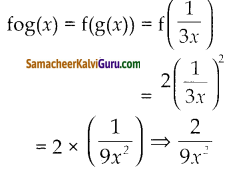
![]()
கேள்வி 11.
f: A → B ஆனது இருபுறச் சார்பு மற்றும் n(B) = 7 எனில் n(A) ஆனது
அ) 7
ஆ) 49
இ) 1
ஈ) 14
விடை :
அ) 7
கேள்வி 12.
f மற்றும் g என்ற இரண்டு சார்புகளும்
f = {(0, 1), (2, 0), (3, -4), (4, 2), (5, 7)}
g = {(0, 2), (1, 0), (2, 4), (-4, 2), (7, 0)}
எனக் கொடுக்கப்பட்டால் fog-ன் வீச்சகமானது
அ) {0, 2, 3, 4, 5}
ஆ) {-4, 1, 0, 2, 7}
இ) {1, 2, 3, 4, 5}
ஈ) {0, 1, 2}
விடை :
{0, 1, 2}
g யில் உள்ள எல்லா உறுப்புகளுக்கும் f ல் தொடர்பு உள்ளது.
fog = {0, 1, 2}
![]()
கேள்வி 13.
f(x) = \(\sqrt{1+x^{2}}\)எனில்
அ) f(xy) = f(x). f(y)
ஆ) f(xy) ≥ f(x). f(y)
இ) f(xy) ≤ f(x). f(y)
ஈ) இவற்றில் ஒன்றுமில்லை
விடை :
ஆ) ஆ) f(xy) ≥ f(x). f(y)
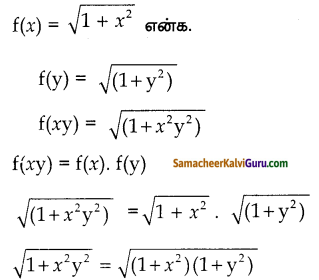
இருபுறமும் வர்க்கம் காண
1 + x2y2 = (1 + x2) (1+y2)
1 + x2y2 = 1 + x2 + y2 + x2y2
எனவே 1+x2y2 < 1 + x2 + y2 + x2y2
கேள்வி 14.
g = {(1, 1) (2, 3) (3, 5) (4, 7) என்ற சார்பானது
g(x) = ax + B எனக் கொடுக்கப்பட்டால் a மற்றும் -வின் மதிப்பானது
அ) (-1, 2)
ஆ) (2, -1)
இ) (-1, -2)
ஈ) (1, 2)
விடை :
(2, -1)
g(x) = ax + β
g(1) = α + β
x, y
(1,1)
g(1) = α + β ………………… (1)
g(2) = 2α + β = 3 ……………….. (2)
x, y
(2, 3)
1, 2 லிருந்து
α = 2
β = -1
![]()
கேள்வி 15.
f(x) = (x + 1)3 – (x -1)3 குறிப்பிடும் சார்பானது
அ) நேரிய சார்பு
ஆ) ஒரு கனச் சார்பு
இ) தலைகீழச் சார்பு
ஈ) இருபடிச் சார்பு
விடை :
இருபடிச் சார்பு
f(x) = (x + 1)3 – (x – 1)3
= x3 + 3x2 + 3x + 1 – x3 + 3x2 -3x + 1
= 6x2 + 2 ஒரு இருபடிச்சார்பு
